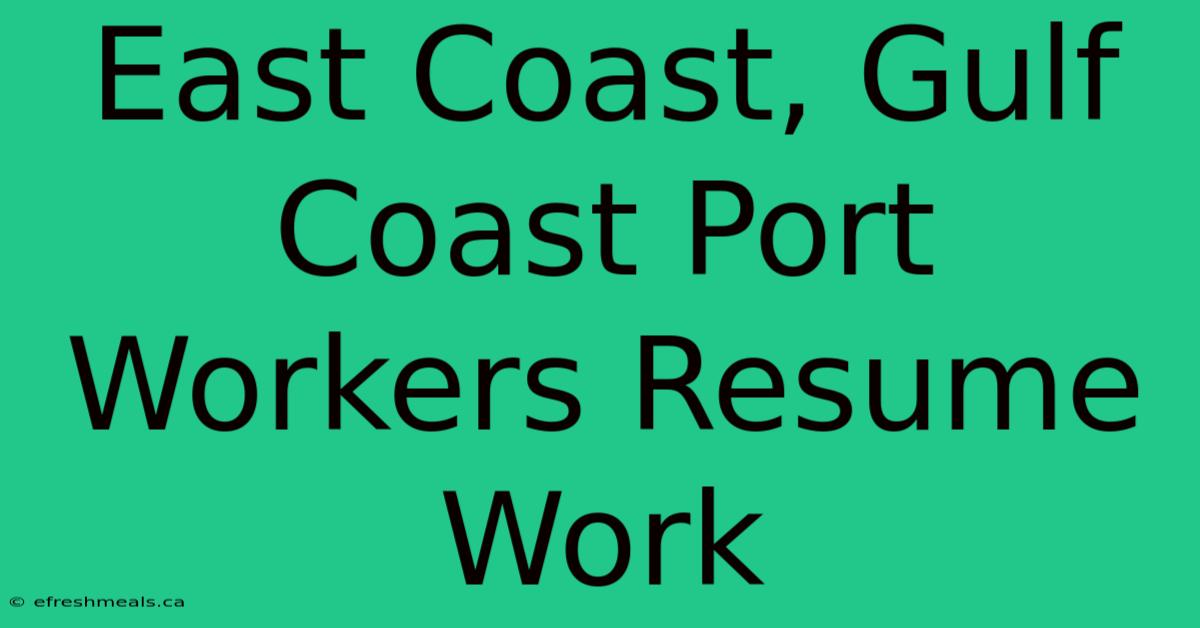East Coast, Gulf Coast Port Workers Resume Work

Discover more detailed and exciting information on our website. Click the link below to start your adventure: Visit Best Website nimila.me. Don't miss out!
Table of Contents
East Coast, Gulf Coast Port Workers Resume Work: A Vital Sign of Recovery
Have major East and Gulf Coast ports resumed operations after recent disruptions? The answer is a resounding yes, with a surge of activity bringing much-needed relief to disrupted supply chains. This resurgence signifies a critical step towards economic recovery.
Why It Matters: The recent disruptions at major ports along the East and Gulf Coasts have sent shockwaves through the global economy. From fuel shortages to labor shortages, these challenges have impacted businesses and consumers alike, resulting in delays, price hikes, and uncertainty. The return to normal operations at these vital hubs signals a crucial step toward stability and economic growth.
Key Takeaways of Port Operations:
| Area | Impact | Current Status | Key Takeaway |
|---|---|---|---|
| Labor Shortages | Reduced workforce capacity, slower loading and unloading | Increased hiring, negotiations for better wages and benefits | Addressing labor needs is crucial for long-term port efficiency. |
| Fuel Shortages | Limited capacity for transport, potential delays | Supply chains stabilizing, fuel prices fluctuating | Fuel availability is a constant concern, requiring proactive measures. |
| Infrastructure Issues | Aging equipment, limited capacity | Investments in upgrades, expansion plans | Modernizing port infrastructure is key for future efficiency. |
| Congestion | Backlogs at ports, delays in goods movement | Enhanced coordination, new technologies | Addressing congestion is a priority for smoother operations. |
East Coast, Gulf Coast Port Workers Resume Work
The recent disruptions at major ports have highlighted the critical role they play in global trade. The resumption of operations signifies a return to normalcy and a crucial step towards economic recovery.
Key Aspects of Port Operations:
Labor: The availability of skilled labor is paramount for efficient port operations. Recent challenges have emphasized the need for fair wages and benefits to attract and retain a qualified workforce.
Infrastructure: The condition of port infrastructure, including equipment and terminals, significantly impacts efficiency. Investing in upgrades and modernizing facilities will be critical for long-term success.
Technology: Advancements in technology, such as automated systems and real-time tracking, can streamline operations and improve efficiency. Embracing these technologies will be vital for the future of port operations.
Port Congestion: Persistent congestion at ports can lead to delays, higher costs, and decreased productivity. Strategies for managing congestion, such as improved coordination and innovative solutions, are essential for maintaining smooth operations.
Fuel Availability: The availability of fuel is a vital factor for cargo transportation. Ongoing efforts to secure reliable and affordable fuel sources are crucial for ensuring uninterrupted port operations.
The Role of Collaboration:
Effective communication and collaboration among stakeholders, including port authorities, workers, shipping companies, and government agencies, are essential for addressing challenges and ensuring a smooth flow of goods.
FAQ
Q: What caused the recent disruptions at East and Gulf Coast ports?
A: A combination of factors contributed to the disruptions, including labor shortages, fuel shortages, and infrastructure challenges.
Q: How are port workers contributing to recovery?
**A: ** Port workers are crucial to the recovery process, working tirelessly to clear backlogs, load and unload ships, and move goods through the supply chain.
Q: What measures are being taken to address fuel shortages?
A: Government agencies and industry leaders are working to address fuel shortages through various measures, including increased production, fuel diversification, and strategic stockpiling.
Q: What are the potential long-term implications of these disruptions?
A: These disruptions highlight the need for resilience and adaptability in the global supply chain. Investments in infrastructure, technology, and workforce development are critical for mitigating future disruptions.
Tips for Businesses
- Diversify Supply Chains: Explore alternative suppliers and shipping routes to mitigate reliance on single ports or routes.
- Track Cargo Carefully: Utilize tracking systems to monitor cargo movement and stay informed about potential delays.
- Communicate Effectively: Maintain open communication with suppliers, customers, and logistics partners to address any issues promptly.
Summary of East Coast, Gulf Coast Port Workers Resume Work
The resumption of operations at East Coast and Gulf Coast ports signifies a vital step toward economic recovery. While challenges remain, the collaborative efforts of port authorities, workers, and industry leaders are essential for navigating these disruptions and ensuring a robust and resilient global supply chain.
Closing Message: The recent disruptions at major ports serve as a stark reminder of the interconnectedness of the global economy. Moving forward, a collaborative approach focused on infrastructure improvements, technological advancements, and skilled labor will be crucial for ensuring smooth and efficient port operations and driving sustainable economic growth.

Thank you for visiting our website wich cover about East Coast, Gulf Coast Port Workers Resume Work. We hope the information provided has been useful to you. Feel free to contact us if you have any questions or need further assistance. See you next time and dont miss to bookmark.
Featured Posts
-
Celtics Affiliate Prepares For Season Start
Nov 01, 2024
-
Cute Halloween Costumes For Pets
Nov 01, 2024
-
Top Lgbtq Halloween Costumes Of 2024
Nov 01, 2024
-
Lafayettes Halloween Exploring Movie Locations
Nov 01, 2024
-
Live Updates Tornado Warning In Ohio
Nov 01, 2024
